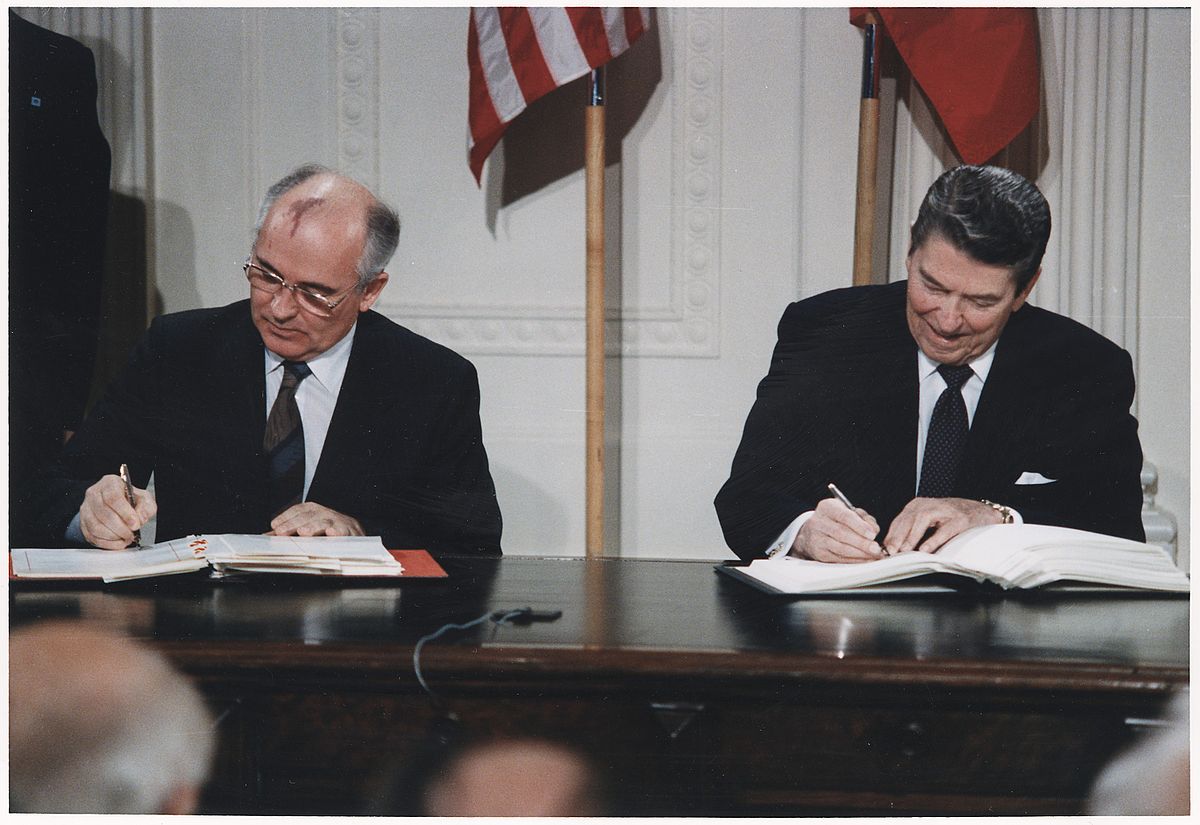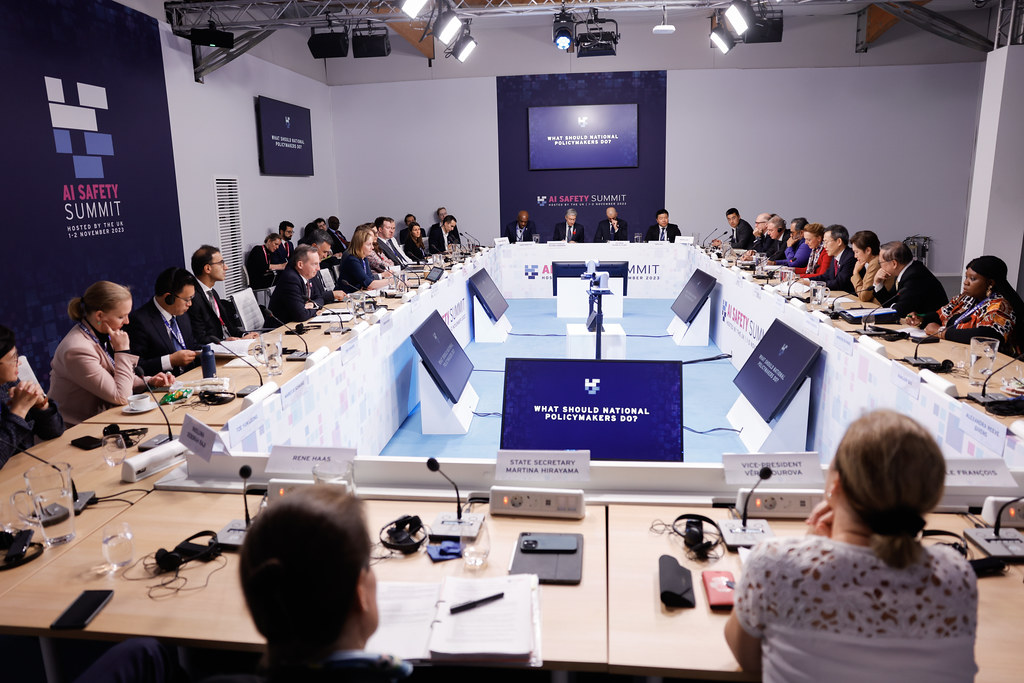U.S. Withdrawal From the INF Treaty: The Facts and the Law
President Trump announced on Oct. 20 that the United States would pull out of the Intermediate-Range Nuclear Forces (INF) Treaty, a 1987 bilateral agreement prohibiting the United States and Russia from possessing, producing or test-flying ground-launched ballistic and cruise missiles with a range of 500 to 5,500 kilometers and their launchers.

Published by The Lawfare Institute
in Cooperation With

President Trump announced on Oct. 20 that the United States would pull out of the Intermediate-Range Nuclear Forces (INF) Treaty, a 1987 bilateral agreement prohibiting the United States and Russia from possessing, producing or test-flying ground-launched ballistic and cruise missiles with a range of 500 to 5,500 kilometers and their launchers. Speaking at a rally in Elko, Nev., Trump cited Russian violations as the chief reason for U.S. withdrawal and said the United States would develop intermediate-range missiles until Russia and China—which is not party to the INF Treaty—agreed to cease development of their own intermediate-range missiles. Interestingly, prior to Trump’s announcement, White House officials had indicated that the administration had not yet decided to withdraw from the treaty. Shortly after the president’s statement, National Security Adviser John Bolton traveled to Moscow to discuss Russia’s violations and the prospect of a U.S. withdrawal.
The INF is the latest in a series of treaties and international agreements that the administration has decided to terminate, and the pace of withdrawals appears to have accelerated since Bolton replaced H.R. McMaster as Trump’s national security adviser. The INF Treaty has long been in Bolton’s sights. In a 2014 Wall Street Journal opinion piece co-authored with John Yoo, entitled “An Obsolete Nuclear Treaty Even Before Russia Cheated,” Bolton criticized the Obama administration for “engaging in contortions to save the INF” in the face of renewed Russian aggression and called on Washington to withdraw from the treaty. Bolton’s personal views aside, there are also real strategic concerns underlying U.S. withdrawal from the INF Treaty, should the administration follow through. Moreover, Trump’s announcement is hardly the first time Russia has been accused of significant breaches of the treaty.
INF Treaty Was a Cold War Success Story
The INF Treaty was a Cold War success story. The process that culminated in adoption of the treaty began in the late 1970s, when the Soviet Union introduced a new nuclear-capable intermediate-range missile, the SS-20, to replace older models of intermediate-range missiles. The SS-20 was mobile, accurate and more easily concealable, and its 5,000-kilometer range could reach Western Europe, North Africa, the Middle East, most of Asia, Southeast Asia and Alaska from Soviet territory. The United States was concerned that this development would give the Soviet Union a strategic edge and would reshape the security environment in Europe and elsewhere.
In consultation and coordination with its NATO allies, the United States advanced a “dual track” approach to address this emerging threat. One prong of this approach focused on deploying new U.S. intermediate-range ballistic and cruise missiles to Europe. The United States and its NATO partners decided to replace the older medium-range Pershing I ballistic missiles with more efficient, longer-range Pershing II missiles and add new ground-launched cruise missiles. The second prong involved bilateral U.S.-Soviet negotiations to secure a reduction of intermediate-range missiles.
After President Ronald Reagan assumed office, he announced in November 1981 that the United States would cancel its deployment plans in exchange for the elimination of Soviet SS-20, SS-4 and SS-5 missiles (known as the “zero-zero option”). By late 1986, the year of the Reykjavik summit, bilateral U.S.-Soviet negotiations had gained traction. In 1987, both parties agreed to eliminate intermediate ballistic and cruise missile systems fitted for land-based weapons delivery with ranges of 500 to 5,500 kilometers. Unlike other bilateral U.S.-Soviet arms-control treaties, which limited only the number of weapons each side was allowed to maintain, the INF Treaty called for eliminating an entire class of weapons. As a result, the Soviet Union destroyed 1,846 missiles and the United States destroyed 846 missiles by May 28, 1991. Shortly thereafter, the United States concluded another arms-control treaty with the Soviet Union that addressed strategic nuclear weapons, known as START I—the Strategic Arms Reduction Treaty (1991). Following the dissolution of the Soviet Union, Russia and the post-Soviet republics assumed the USSR’s obligations under the INF Treaty.
A History of Russian Violations
The Obama administration reinvigorated arms-control cooperation with Russia, which culminated in the conclusion in 2010 of New START— a successor of previous instruments that places limits on possession and deployment of strategic weapons, including nuclear warheads, nuclear bombs and inter-continental ballistic missiles. As recently as February 2018, both the U.S. and Russia appeared to be meeting their arsenal-reduction obligations under the treaty.
At the same time, friction developed with regard to INF compliance. The administration was aware of evidence of Russian noncompliance as early as 2008. In July 2014, President Obama officially accused Russia of testing an intermediate-range land-launched missile in violation of the INF Treaty. Every year since 2014, the State Department’s Annual Report on “Adherence to and Compliance with Arms Control, Non-proliferation, and Disarmament Agreements and Commitments” has cited Russian violations of the INF Treaty.
While few details about the nature of Russia’s violations were made public, the Obama administration demanded that the Russian government terminate all testing of the land-launched missile. For the first time since 2003, the administration also convened two meetings of the Special Verification Commission (SVC) pursuant to Article XIII of the INF Treaty in 2016 and 2017 to discuss compliance challenges. (See Rick Houghton’s discussion of the SVC.) At those meetings, Russia denied breaching the treaty.
In March 2017, Gen. Paul Selva, vice chairman of the Joint Chiefs of Staff, told the House Armed Services Committee that Russia had fired a land-launched cruise missile in violation of the INF, posing a risk to “most of our facilities in Europe.” The 2018 State Department Compliance Report identified the Russian designator for the missile—9M729. In response to Russia’s alleged non-compliance, the Commerce Department has imposed sanctions on Russian companies that participated in development of the missile. Following an INF policy review concluded in late 2017, the Trump administration announced that it would continue to seek a diplomatic resolution with Russia through the SVC, while “commencing INF Treaty-compliant research and development … by reviewing military concepts and options for conventional, ground-launched, intermediate-range missile systems.” The administration also raised the specter of a U.S. withdrawal from the INF: The 2018 Nuclear Posture Review warned that “the United States will not forever endure Russia’s continuing non-compliance.”
In their July 2017 Brussels Summit Declaration, NATO members recognized the threat of Russian non-compliance with the INF, citing Russia’s 9M729 missile system. NATO members further stressed that “in the absence of any credible answer from Russia on this new missile, the most plausible assessment would be that Russia is in violation of the Treaty.” A few months later, NATO’s North Atlantic Council reiterated that the U.S. was in full compliance with the INF Treaty but that Russia possessed a missile system that raised “serious concerns.” In response to President Trump’s announcement, NATO Secretary General Jens Stoltenberg again backed U.S. allegations that Russia has violated the INF. He stressed that "[t]he treaty is not working if it's only being respected by one side. The problem, the threat, the challenge is the Russian behaviour, which has been ongoing for a long time." The European Union, by contrast, called on the U.S. to remain in the treaty and warned that a U.S. withdrawal would ignite an arms race and undermine a central pillar of Europe’s security architecture.
Russia has remained firm in denying that it has violated the INF, labeling reports that it had deployed missiles in violation of the treaty as “Fake News.” In addition, Russia has accused the United States of violating the INF. Among the violations cited by Moscow are the development of the Aegis Ashore Ballistic Missile Defense system and ballistic target missiles, along with the U.S. use of armed unmanned aerial vehicles (UAVs). The State Department provided a detailed rebuttal in 2017.
The China Angle
When the United States and the Soviet Union signed the INF Treaty in 1987, the world’s supply of intermediate-range missiles was limited to those two states as well as European NATO members. Since that time, however, new powers unconstrained by treaty obligations—unlike Russia—have developed and tested intermediate-range ballistic and cruise missiles. In particular, China’s intermediate-range ballistic missiles now constitute “approximately 95 percent” of the People’s Liberation Army missile force.
Consequently, Moscow has repeatedly expressed concern in light of efforts by China, North Korea and Iran to acquire intermediate-range missiles. In the past, Russia expressed support for the idea of expanding the INF to include more states, and in 2007 Russia and the U.S. issued a joint statement in support of imparting a “global character to this important regime.” But as ambitions for a multilateral INF have retreated, China’s stockpile of intermediate-range missiles has grown—as has Russian skepticism of the merits of the treaty itself. In June 2013, then-Prime Minister Vladimir Putin complained that “nearly all of our neighbors are developing these kinds of weapons systems” and described the Soviet Union’s decision to conclude the INF Treaty as “debatable to say the least.”
The United States appears to share the concern that its continued adherence to the INF Treaty jeopardizes not only the U.S. strategic posture vis-à-vis Russia but also its ability and readiness to counter the missile threat from China and other actors. Bolton expressed this view in his 2014 op-ed, and it now appears to reflect the view of the Trump administration. On Oct. 22, Trump remarked that “China is not included in the agreement. They should be included in the agreement.”
In light of China’s unfettered development of intermediate-range ballistic missiles, some commentators have welcomed the administration’s intent to terminate the INF Treaty. Writing for the National Interest, Nathan Levine argues that the development and placement of intermediate-range ballistic missiles in Japan, Guam, the southern Philippines or northern Australia would enable the United States to check China’s aggression in the Pacific while minimizing danger to U.S. forces and assets. Writing for Bloomberg News, Eli Lake maintains that Trump made the right choice—likening Trump’s strategy to Reagan’s decision to enhance the deployment of intermediate-range missiles in Europe, which forced the Soviet Union to come to the negotiating table.
Others have criticized the president’s move. Some commentators have focused on the haphazard manner in which the president appears to have handled the potential INF withdrawal, expressing concern that it sends a clear signal of unilateralism to the rest of the world that undermines trust in U.S. commitment to treaties. For example, one former NATO supreme allied commander, Gen. Philip Breedlove, commented, “We have to take action…[but] it needs to be in accordance and in coordination with our allies ... we have to embrace Europe and move forward with Europe.” Jim Miller, former undersecretary of defense for policy in the Obama administration, similarly said that “[t]he rollout of this decision put the U.S. in the position of being the one that will have killed the treaty, and that will be detrimental to our ability to work not just with Russia or China, but our allies as well, and it will be detrimental to our ability to sustain the New START Treaty, which is even more in the U.S. interest than the INF treaty.”
Some critics have highlighted the risks involved in the resumption of U.S. development of intermediate-range missiles, something Trump’s comments and the administration's policy review suggest is likely. A U.S. pullout from the INF Treaty, in this view, could trigger an arms race between the United States, Russia and China, with destabilizing consequences for the U.S. and its allies. Steven Pifer, a former U.S. ambassador to Ukraine, said that “Once the United States withdraws from the treaty, there is no reason for Russia to even pretend it is observing the limit…Moscow will be free to deploy the 9M729 cruise missile, and an intermediate-range ballistic missile if it wants, without any restraint.” An INF pullout would also add to concerns of an arms race triggered by the Trump administration’s Nuclear Posture Review, which, according to the Federation of Atomic Scientists, “reverses decades of bipartisan policy and orders what would be the first new nuclear weapons since the end of the Cold War.”
For their part, Russia and China have reacted negatively to the news of an impending U.S. withdrawal from the INF Treaty. Chinese Foreign Ministry spokesperson Hua Chunying said that “Unilateral withdrawal will have a multitude of negative effects.” Russia similarly has criticized the decision, though local media sources seem to suggest many Russians question the credibility of Trump’s threat of withdrawal. At least one Russian politician suggested that Trump’s announcement is simply “blackmail.” Russian Senator Konstantin Kosachev, who chairs the Federation Council’s Foreign Affairs Committee, wrote on his Facebook page that since no formal steps have been taken by the U.S. to trigger the INF Treaty’s termination clause, “Trump’s statement qualifies as continuing blackmail rather than an accomplished act of law.”
INF Termination by the U.S. From a Legal Perspective
There is room for interpretation as to whether Trump and Bolton’s statements indicated an intention to withdraw the United States from the INF Treaty entirely or merely to suspend its operation in whole or in part due to a material breach by Russia. Under Article 60(1) of the Vienna Convention on the Law of Treaties (VCLT), which is widely considered as customary international law, “A material breach of a bilateral treaty by one of the parties entitles the other to invoke the breach as a ground for terminating the treaty or suspending its operation in whole or in part.” In other words, the United States has the right to either suspend or terminate a treaty if a material breach occurs. If Russia in fact deployed an INF-class missile, that would arguably qualify as a material breach.
If the administration in fact intends to withdraw from the treaty, it would need to follow Article XV of the INF Treaty, which outlines the conditions and procedure for withdrawal:
1. This Treaty shall be of unlimited duration.
2. Each Party shall, in exercising its national sovereignty, have the right to withdraw from this Treaty if it decides that extraordinary events related to the subject matter of this Treaty have jeopardized its supreme interests. It shall give notice of its decision to withdraw to the other Party six months prior to withdrawal from this Treaty. Such notice shall include a statement of the extraordinary events the notifying Party regards as having jeopardized its supreme interests.
As far as we are aware, the U.S. has not yet issued a formal notice of withdrawal clarifying what “extraordinary events” necessitated it. Bolton told the Wall Street Journal on Monday that while the president strongly intends to withdraw, the U.S. would consult its European and Asian allies, in addition to Russia, before making a formal announcement. On Tuesday, Bolton reiterated that an official announcement would be made “in due course” and that no progress had been made over two days of talks in Moscow. It might be that the threat of withdrawal is a negotiation tactic aimed at pressuring Russia to comply with the INF and putting pressure on China to accept limitations on its own arsenal.
If the U.S. follows through with withdrawal, it would be able to point to plausible claims that could satisfy the requirements of the INF termination clause. Even if we interpret “extraordinary events related to the subject matter of this Treaty” as referring only to relevant developments along the U.S.-Russia axis, the U.S. has a credible claim of repeated, prolonged Russian non-compliance with the core obligations of the INF Treaty, which the treaty’s dispute resolution mechanism failed to resolve. Adding China’s growing missile arsenal to the mix would only strengthen the U.S. claim. Therefore, there seem to be no significant legal obstacles preventing the U.S. from terminating the treaty under international law. The main question from the international perspective is whether this move—should it be executed—is wise and prudent, not whether termination is lawful.
Neither is Trump likely to face significant legal hurdles at home. Congress has long expressed concern about the INF Treaty in light of evidence of Russian non-compliance, holding hearings to address the subject. In 2015, Congress attempted to nudge the Obama administration into leveraging continued U.S. compliance with New START to pressure Russia into complying with the INF Treaty. Furthermore, in the past few years, most recently in the National Defense Authorization Act (NDAA) for fiscal 2019, Congress has required the president to submit a determination to Congress on Russia’s compliance with the INF Treaty and whether the treaty’s key prohibitions “remain binding on the United States as a matter of United States law” (Section 1243). The NDAA also expressed the sense of Congress that Russia’s testing and deployment of missiles covered by INF constituted a material breach of the treaty, defeating its object and purpose. Therefore, it was the sense of Congress that the United States “is legally entitled to suspend the operation of the INF Treaty” (Section 1244).
As such, Congress has given a clear statement supporting the suspension—if not the termination—of the INF Treaty in light of a material breach. Even in the absence of this statement, Trump likely has the domestic constitutional authority to terminate the treaty unilaterally, without congressional approval. While the Constitution lays out the process for entering into treaties, vesting the power to conclude treaties in the president with the advice and consent of two-thirds of the Senate, it is silent with respect to which government branch has the power to terminate treaties. Still, as Curtis Bradley has observed, since the early 20th century executive-branch practice and congressional inaction have led to a broad consensus that presidents have unilateral power to terminate treaties, especially when the treaty contains a termination clause. (As Scott Anderson observes, however, it is important to note that one could interpret Congress’s statement as sanctioning only the suspension of the treaty, not a withdrawal. Interesting questions arise under this interpretation as to whether such implicit congressional rejection of withdrawal trumps the president’s unilateral power to terminate the treaty.)
In the few cases in which the courts have been called to address this issue, they did not prevent the president from exercising unilateral termination authority. In Goldwater v. Carter, the Supreme Court famously declined to adjudicate whether President Jimmy Carter’s unilateral termination in 1978 of the 1954 Mutual Defense Treaty with Taiwan—undertaken as part of a realignment of the U.S. relationship with China—was constitutional. Prior to the treaty’s termination, Congress had enacted the International Security Assistance Act, in which it expressed the sense of Congress that the executive should consult the legislature before making any policy changes that might affect the 1954 Taiwan Treaty. Extensive debates ensued in the Senate, but that chamber ultimately failed to vote on a resolution that required Senate approval to terminate the Taiwan Treaty. A group of senators and members of the House then turned to the courts. When the case reached the Supreme Court, four justices concluded that the case presented a non-justiciable political question, while Justice Lewis Powell, adding his vote to the majority, said he would dismiss the case on the ground that it was not ripe for adjudication.
In 2002, President George W. Bush’s withdrawal from the Anti-Ballistic Missile (ABM) Treaty made its way to court in Kucinic v. Bush—the most recent case of a unilateral termination by the U.S. of a bilateral arms-control treaty with Russia. The U.S. District Court for the District of Columbia dismissed the case, brought by a group of members of Congress, on standing and political-question grounds. In light of the clear expression of Congress’s position on the INF matter, there is little reason to believe that the courts would weigh in against termination of the INF Treaty by the president, should the issue make its way into a courtroom.
Conclusion
It remains to be seen whether the Trump administration will follow through with termination of the INF Treaty. While the administration would likely not face any legal hurdles in doing so, the strategic value of withdrawal is less certain. On the one hand, continued U.S. compliance in the face of Russian non-compliance undercuts the U.S. strategic position, especially considering the INF-class missile systems that other actors have acquired. Furthermore, NATO appears to support a tougher stance against Russia on INF compliance. Nevertheless, a U.S. withdrawal from the INF Treaty would constitute yet another retreat from international instruments and institutions. When coupled with the Trump administration’s intent to replenish the U.S. nuclear arsenal, withdrawal might undermine other long-standing international arms-control regimes, including the Nuclear Non-Proliferation Treaty, and encourage other actors to opt out and fend for themselves.






